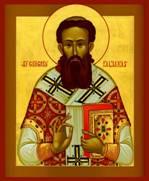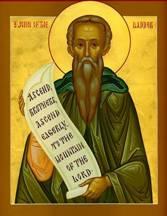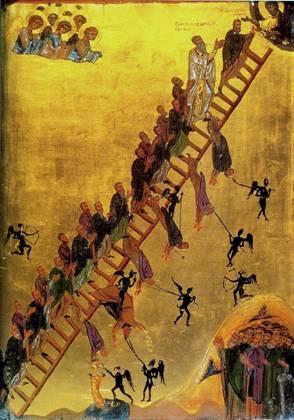Church Established: St. Gregory Palamas and St. John Climacus
WEEK 3: ST. GREGORY PALAMAS AND ST. JOHN CLIMACUS
Triodion:
These great saints, along with St. Mary of Egypt, form part of the Triodion. What is the Triodion? It is named for the service book used for the 10 weeks preceding Pascha. Triodion Season is the preparation for Easter. The lives of these great men and their contributions to Orthodoxy have given them a special place in our services, year after year. St. Gregory is remembered on the 2nd Sunday of Great Lent and St. John on the 4th.
Their lives (in brief):
1. St. Gregory Palamas: Gregory was born in the royal city of Constantinople in 1296 AD. His father was a Senator and a member of the Imperial court. At age 7, both of his parents died, and Gregory was an orphan. But, the orphan boy was a favorite of Emperor Andronicus II, who sent the boy to school, where Gregory studied all about science. Science, however, did not interest Gregory; his interest was in the Lord Jesus. He soon began studying about the Lord and at age 20 gave up his life in the court of the emperor to spend his time in monasteries in Constantinople and Mt. Athos.
When Gregory was 30 years old, he became a priest in Thessalonica. He had learned well from the monks around Constantinople and Mt. Athos. They had taught him the Hesychast Prayer, or Jesus Prayer. The monks would bow in prayer, concentrate on the Lord, and recite, “Lord Jesus Christ, Son of God, have mercy upon me, a sinner.” This prayer came originally from Jesus’s parable of the Publican and the Pharisee. As the monk prayed and prayed, over the years he would grow closer to the Lord and experience the light of the closeness of Jesus. With Jesus as the sun, Gregory and the other monks could feel the light and warmth of His shining rays. “Hesychast” means calm or silence; it’s difficult to come close to the Lord in the busyness of everyday life. Gregory, as a priest/monk, would spend 5 days each week as a hermit, and then Saturday and Sunday ministering to the people.
But, in those days, a man named Barlaam was teaching also. Barlaam had studied about Jesus but had not spent years in prayer just getting to know Jesus. In fact, Barlaam didn’t believe that people could get to know Jesus, not to really feel Him near, until after they died. He made fun of the monks and called them “Belly-button-gazers” because they spent so much time kneeling and bowing in prayer.
|
Gregory knew that Barlaam was wrong. Gregory knew Jesus in his heart and had felt His presence with him. Gregory had seen and felt the light of God -- the same light that St. Stephen saw as he was being stoned, that St. Peter saw when Jesus was transfigured on the mountain, and that St. Paul saw on the road to Damascus. He knew that the Lord was present with all of His followers since the coming of the Holy Spirit at Pentecost. This Holy Spirit, the same Spirit who appeared from heaven when Jesus was baptized in the form of a dove, was just as much a part of |
 as God the Father or God the Son, Jesus. Gregory defended the monks and their vision in his teachings as a priest and in his writings. He used the metaphor of the sun and its rays to describe what the monks meant – God was the sun but His energies are the rays. We can feel these rays; they give us both heat and light and life. They are not the sun, but are quite real and would still be there, even if there were no one to feel their warmth. Thus, man, with proper preparation in prayer and repentance and purification can experience the divine light of God’s energy. He told the world that Barlaam was wrong -- that every Christian can draw near to God through prayer. He defended the monastic position in his written works, the “Hagiorite Tome” and also in debate at a council held in Constantinople in 1341. The council agreed with Gregory and condemned the beliefs of Barlaam and his followers.
as God the Father or God the Son, Jesus. Gregory defended the monks and their vision in his teachings as a priest and in his writings. He used the metaphor of the sun and its rays to describe what the monks meant – God was the sun but His energies are the rays. We can feel these rays; they give us both heat and light and life. They are not the sun, but are quite real and would still be there, even if there were no one to feel their warmth. Thus, man, with proper preparation in prayer and repentance and purification can experience the divine light of God’s energy. He told the world that Barlaam was wrong -- that every Christian can draw near to God through prayer. He defended the monastic position in his written works, the “Hagiorite Tome” and also in debate at a council held in Constantinople in 1341. The council agreed with Gregory and condemned the beliefs of Barlaam and his followers.
Later in life, Gregory was made Archbishop of Thessalonica. But, the Barlaamites were not finished, since many people still held to their beliefs. Gregory suffered many times because of his teachings; he was thrown out of his home, was thrown in prison, and was even captured by the Moslem Turks. What did he do while in jail awaiting ransom? He preached to the Turks! But, finally, before his death, two church councils in Constantinople held firm for Gregory’s teachings and told all of us that we can know and feel the presence of God in our daily lives. In the last three years of his life, again in Thessalonica as Archbishop, the prayers of St. Gregory healed many people. Finally, he saw a vision of St. John Chrysostom, calling him home. With the words "To the heights! To the heights!" St Gregory Palamas fell asleep in the Lord on November 14, 1359. St. Gregory is buried at the Cathedral of Thessalonica.
 2. St. John Climacus: John was born in the land of Palestine, about 600 years after the time of Jesus. He was an excellent student in school and would have been able to be rich and important in the court of the king. But, when John was only 16 years old, he left the world of riches and fame and traveled to the monastery on Mt. Sinai to become a monk. He wanted more than anything else to grow closer and closer to Jesus.
2. St. John Climacus: John was born in the land of Palestine, about 600 years after the time of Jesus. He was an excellent student in school and would have been able to be rich and important in the court of the king. But, when John was only 16 years old, he left the world of riches and fame and traveled to the monastery on Mt. Sinai to become a monk. He wanted more than anything else to grow closer and closer to Jesus.
In the monastery, on the wild and rocky slopes of Mt. Sinai, John became the disciple of an old and wise monk who was called his elder. Every day, John came to his elder and opened his heart and all his thoughts, good and bad. He followed obediently any advice the elder offered and worked willingly at any task he was given. He was cheerful and friendly with everyone.
After four years in the monastery, John was a committed monk. He moved to a hermitage, or small hut, nearby to be alone with the Lord. There he spent 40 years. John read the Bible constantly and prayed for hours at a time. During those 40 years, his greatest dream became truer and truer – he did grow close to the Lord.
Other monks began to see the holiness in this solitary monk and to come to him for direction and advice. Many began to compare John with Moses. Though he lived alone, John loved people. He was always concerned about them and prayed with all his heart when they were in need. One day, one of the monks he was teaching was working far from John’s cell. He lay down to rest in the shade of a big rock when the sun became hot. Suddenly, he heart John’s voice calling him. He jumped up, but saw no one at all. At that moment, a huge rock broke off and fell on the very spot where he had been resting. The disciple ran back to the cell to tell John what had happened. Joh told him that he, too, had been resting when suddenly he heard the Lord telling him that his friend and disciple was in terrible danger. He immediately got up and began to pray. So his disciple was warned and his life was saved.
John is best known for his book called “Ladder of Divine Ascent” and from the word for ladder, “klimax”, he is to this day called St. John Climacus. The abbot of the monastery asked John to write the book about his own experience of growing closer to God. The book tells of 30 steps in spiritual growth and has been used for hundreds of years as a guide for monks and others wanting greater holiness.
John was also loved by the other monks for his compassion and his healing of their spiritual struggles. They often came to him for advice or prayer when life seemed too hard to face. So, when John was 70 years old, he was chosen to be abbot of the monastery. He led the monks wisely and well.
John was also known outside the monastery. Travelers came from all over to talk with the holy abbot. When a drought came to the land and there was no rain and no water to drink, the people of Mt. Sinai came to John for prayer. John prayed and the rain fell. Finally, as an old man of 80, St. John Climacus died peacefully.
The Hesychast movement vs. Scholasticism
- The Hesychast movement in the East was led by the monks. Review the Jesus prayer and the arguments of St. Gregory Palamas against Barlaam. St. John Climacus also clearly taught that closeness to God was possible in his book, “The Ladder of Divine Ascent”. The monks of the East developed the form of prayer called “hesychasm”, with intense concentration and certain body postures. The word itself means quietness or calm. The Orthodox Church has always felt that man could draw near to God through prayer and continues to this day.
- In the West, a different philosophy prevailed. Around the 12th century, “scholasticism” developed, trying to use reason to understand God and teach Christianity. Thus, the Western Church developed a different way of thinking. Thomas Aquinas was the most famous proponent of this scientific way of proving the nature of God’s existence. Man can, by his own efforts and reason, improve his own life and need not “resort” to divine intervention. The great questions of life can be answered by logic and reason, not divine revelation or eternal truth.
Jesus Prayer Scramble: Memory work for this week is the Jesus Prayer. As a learning game, play Jesus Prayer Scramble: Make two or three sets of cards, each with one card containing one word of the Jesus prayer. Divide the class into teams. Give each team a stack of cards, mixed up. See which team can first arrange the cards in the correct order. Can each student say the Jesus Prayer?
Primstav: Add St. Gergory Palamas on November 14, and St. John Climacus on March 30. How will they be symbolized? Who’s the dove and who’s the ladder?
Close with the Jesus Prayer. Ask students to agree to say the Jesus Prayer every day this week.
